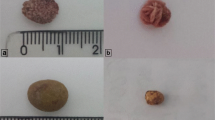Summary
Experiments were performed to clarify the debate over the entry of circulating proteins into the epididymal lumen by use of the marker horseradish peroxidase (HRP). Epididymal tubules from the caput epididymidis of the rat were immersed in medium TC 199 containing HRP (3.5 mg/ ml) for 5 min to 3 h at 33° C. Sections were examined for the presence of tracer within the epithelial cells by electron microscopy. From 5 min to 3 h, vesicles containing peroxidase reaction products were found throughout the cytoplasm of the principal cells. Vesicles occurred close to both the basal and apical membranes, and many were found opening into the interstitial space and lumen, depending on the length of incubation. By 5 min labelled vesicles were infrequently found in the apical part of the cells. Reaction product was observed in the epididymal lumen adhering to the microvilli from 30 min of incubation onwards. At all periods of incubation peroxidase was present at the base of the epithelium and between the cells, but it was never found within the tight junctional complexes, and no reaction deposits were found within epithelial cells of tubules incubated in the absence of peroxidase. It is concluded that large molecules leaving the capillaries may enter the epididymal lumen in the caput by means of fluid-phase endocytosis.
Similar content being viewed by others
References
Aragon JA, Lustig L, Mancini RE (1972) Uptake of horseradish peroxidase by the testis and epididymis of mice. I. Light-microscopical study. J Reprod Fertil 28:299–302
Bedford JM, Weininger RB, Fisher S, Rifkin J (1982) Specific IgG levels appearing in the cauda epididymidis of male rabbits. Int J Androl Suppl 5:48–52
Cuasnicú PS, Gonzalez Echeverría F, Piazza A, Piñeiro L, Blaquier JA (1984a) Epididymal proteins that mimic the androgenic effect on zona pellucida recognition by immature hamster spermatozoa. J Reprod Fertil 71:427–431
Cuasnicú PS, Gonzales Echeverría F, Piazza AD, Cameo MS, Blaquier JA (1984b) Antibodies against epididymal glycoproteins block fertilizing ability in rat. J Reprod Fertil 72:467–471
Djakiew D, Byers SW, Dym M (1984) Receptor-mediated endocytosis of alpha2-macroglobulin and transferrin in rat caput epithelial cells in vitro. Biol Reprod 31:1073–1085
Djakiew D, Byers SW, Dym M (1985) Receptor-mediated endocytosis of alpha2-macroglobulin by principal cells in the proximal caput epididymidis in vivo. J Androl 6:190–196
Dym M (1973) The fine structure of the monkey (Macaca) Sertoli cell and its role in maintaining the blood-testis barrier. Anat Rec 175:639–656
Fournier-Delpech S, Courot M, Dubois MP (1985) Decreased fertility and motility of spermatozoa from rats immunized with a prealbumin epididymal specific glycoprotein. J Androl 6:246–250
Friend DS (1969) Cytochemical staining of multivesicular bodies and Golgi vesicles. J Cell Biol 41:269–279
Friend DS, Gilula NB (1972) Variations in tight and gap junctions in mammalian tissues. J Cell Biol 53:758–776
Hinton BT (1985) The Blood-Epididymis Barrier. In: Male Fertility and its Regulation. Eds TJ Lobl and ESE Hafez, MTP Press Lancaster, pp 371–382
Hinton BT, Howards SS (1981) Permeability characteristics of the epithelium in the rat caput epididymidis. J Reprod Fertil 63:95–99
Hinton BT, Dott HM, Setchell BP (1979) Measurement of the motility of rat spermatozoa collected by micropuncture from the testis and from different regions along the epididymis. J Reprod Fertil 55:167–172
Hoffer AP, Hinton BT (1984) Morphological evidence for a blood-epididymis barrier and the effects of gossypol on its integrity. Biol Reprod 30:991–1004
Le Lannou D, Chambon Y, le Calve M (1979) Role of the epididymis in reabsorption of inhibin in the rat. J Reprod Fertil Suppl 26:117–121
Lipner H, Rush ME (1981) Site of absorption of testicular inhibin. Fed Proc 40:473 (abst)
Moore HDM, Bedford JM (1979) The differential absorptive activity of epithelial cells of the rat epididymis before and after castration. Anat Rec 193:313–328
Suzuki F, Nagano T (1978) Regional differences of cell junctions in the excurrent duct epithelium of the rat testis as revealed by freeze fracture. Anat Rec 191:503–520
Weininger RB, Fisher S, Rifkin J, Bedford JM (1982) Experimental studies on the passage of specific IgG to the lumen of the rabbit epididymis. J Reprod Fertil 66:251–258
Wong PYD, Tsang AYF, Lau HK (1983) Restricted entry of an anti-rat epididymal protein IgG into the rat epididymis. Int J Androl 6:275–282
Yeung CH, Cooper TG (1982) Ultrastructure of the perfused rat epididymis: effects of luminal sodium ion concentration. Cell Tissue Res 226:407–425
Author information
Authors and Affiliations
Rights and permissions
About this article
Cite this article
Cooper, T.G., Yeung, C.H. & Bergmann, M. Protein transport to the epididymal lumen. Cell Tissue Res. 248, 527–530 (1987). https://doi.org/10.1007/BF00216479
Accepted:
Issue Date:
DOI: https://doi.org/10.1007/BF00216479




